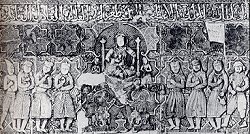


Notice: This is the official website of the All Empires History Community (Reg. 10 Feb 2002)
Central Asian paintings and sculpture |
Post Reply 
|
| Author | |
Cyrus Shahmiri 
Administrator 

King of Kings Joined: 07-Aug-2004 Location: Iran Online Status: Offline Posts: 6240 |
 Quote Quote  Reply Reply
 Topic: Central Asian paintings and sculpture Topic: Central Asian paintings and sculpturePosted: 13-Jan-2005 at 15:08 |
|
Source: http://www.unesco.org/culture/asia/html_eng/chapitre4216/cha pitre8.htm Wall paintings showing thematic compositions, and also sculpture, were commonly included in the interior decor of both secular and religious buildings in Central Asia during the pre-Islamic period. However, the arrival of Islam brought about changes in the nature of religious buildings and palaces which, together with religious prohibitions, led to changes in the forms and stylistic features of both sculpture and wall painting. This process, which developed variously in different regions of the Islamic world, continued for many decades. The wall paintings and sculptures discovered in the palaces of the eighth to the ninth century near Samarkand (Panjikent, Afrasiab), Bukhara (Varakhsha) and Nishapur represent the splendid swansong of the representational arts of early medieval Sogdia and Iran. In the Sasanian period, when glorification of the legendary and epic past was encouraged, the interiors of palaces were still being decorated with paintings and sculptured reliefs illustrating hunting scenes, royal receptions (Fig. 10) and epic themes recalling the lives of ancient kings, as witness the paintings from Afrasiab and Varakhsha. The motifs of Sasanian art are encountered in mural compositions and stucco carvings of the eighth and ninth centuries discovered in the remains of Islamic palace buildings of Nishapur. A traditional hunting scene is depicted on a fragment of wall painting but the appearance of different figures and attributes must be viewed as a concession to the new era. Instead of the lion hunts favoured by the Sasanians, the picture shows a horseman with a hawk on his forearm: his prey is a hare. The grand, monumental quality of Sasanian art gives place to the stylized decorative compositions of the new age.
|
|

|
|
 |
|
Post Reply 
|
| Forum Jump | Forum Permissions  You cannot post new topics in this forum You cannot reply to topics in this forum You cannot delete your posts in this forum You cannot edit your posts in this forum You cannot create polls in this forum You cannot vote in polls in this forum |
Copyright ©2001-2009 Web Wiz
This page was generated in 0.141 seconds.












 Printable Version
Printable Version Google
Google Delicious
Delicious Digg
Digg StumbleUpon
StumbleUpon Windows Live
Windows Live Yahoo Bookmarks
Yahoo Bookmarks reddit
reddit Facebook
Facebook MySpace
MySpace Newsvine
Newsvine Furl
Furl Topic Options
Topic Options